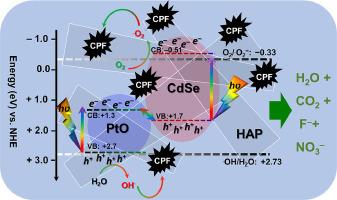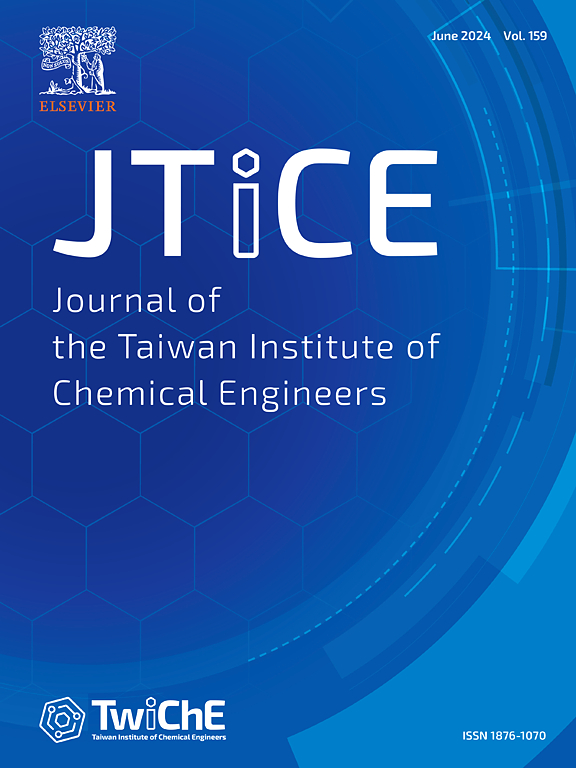用 CdSe 和 PtO 纳米粒子装饰介孔羟基磷灰石纳米棒以增强对水中抗生素污染物的光催化氧化作用
IF 5.5
3区 工程技术
Q1 ENGINEERING, CHEMICAL
Journal of the Taiwan Institute of Chemical Engineers
Pub Date : 2024-11-14
DOI:10.1016/j.jtice.2024.105818
引用次数: 0
摘要
背景在水源中检测到的大量抗生素污染物已成为全球关注的问题。在半导体光催化剂的作用下,光催化过程有望在光照下降解有机化合物。方法通过双表面活性剂辅助溶胶-凝胶法,设计并合成了创新的高比表面积介孔羟基磷灰石(HAP)纳米棒。该新型光催化剂在 712 纳米波长处显示出吸收边缘,带隙能估计为 1.PtOCdSe/HAP 纳米复合材料抑制了电子和空穴的重组,提高了在宽可见光谱范围内的吸收率,从而大大提高了降解 CPF 的光催化能力。最佳 PtOCdSe/HAP 光催化剂的光催化能力在光照 30 分钟后的最大降解率为 100%,远高于 CdSe(44%)和 CdSe/HAP(82%)。PtOCdSe/HAP 光催化剂的增强速率常数为 0.0359 min-1,分别是纯 CdSe(0.008 min-1)和 CdSe/HAP (0.0203 min-1)的 4.488 倍和 1.768 倍。PtOCdSe/HAP 纳米复合材料光催化能力的增强主要得益于 PtO 和 CdSe 的协同效应、大表面积的孔隙结构以及光电载流子的高效电荷分离。重复使用的纳米复合材料在连续五个周期内的光催化能力略有下降(98.5%),这表明其具有相当高的稳定性。这项工作为设计基于 HAP 的光催化剂在太阳能下去除抗生素打开了大门。本文章由计算机程序翻译,如有差异,请以英文原文为准。

Decoration of mesoporous hydroxyapatite nanorods by CdSe and PtO nanoparticles for enhanced photocatalytic oxidation of antibiotic pollutant in water
Background
A large variety of antibiotic pollutants in water sources has been detected being a worldwide concern. The photocatalytic process is promising to degrade the organic compound under illumination in the presence of semiconductor photocatalysts
Method
Design and synthesis of innovative of mesoporous hydroxyapatite (HAP) nanorods with a high surface area was achieved through the dual surfactant-assisted sol-gel approach. Then, HAP nanorods were decorated by CdSe and PtO nanocrystals as active visible-photocatalyst to degrade Ciprofloxacin (CPF) as a pollutant model
Significant Findings
The novel photocatalyst exhibited an absorption edge at 712 nm with estimated bandgap energy of 1.77 eV The PtO![]() CdSe/HAP nanocomposite highly improved the photocatalytic ability towards degradation CPF by suppressing the recombination of electrons and holes and boosting the absorption in wide visible spectra. The photocatalytic ability of optimal PtO
CdSe/HAP nanocomposite highly improved the photocatalytic ability towards degradation CPF by suppressing the recombination of electrons and holes and boosting the absorption in wide visible spectra. The photocatalytic ability of optimal PtO![]() CdSe/HAP photocatalyst demonstrated a maximum degradation of 100 % after 30 min of illumination time, much larger than those of CdSe (44 %) and CdSe/HAP (82 %). The PtO
CdSe/HAP photocatalyst demonstrated a maximum degradation of 100 % after 30 min of illumination time, much larger than those of CdSe (44 %) and CdSe/HAP (82 %). The PtO![]() CdSe/HAP photocatalyst showed an enhanced rate constant of 0.0359 min–1 which is larger 4.488 and 1.768 times compared to pure CdSe (0.008 min–1) and CdSe/HAP (0.0203 min–1). This enhanced photocatalytic ability of PtO
CdSe/HAP photocatalyst showed an enhanced rate constant of 0.0359 min–1 which is larger 4.488 and 1.768 times compared to pure CdSe (0.008 min–1) and CdSe/HAP (0.0203 min–1). This enhanced photocatalytic ability of PtO![]() CdSe/HAP nanocomposite is interpreted by the synergetic effect between PtO and CdSe, large surface area with pores structure and efficient charge separation of the photocharge carriers. The reused nanocomposite showed a slight reduction in the photocatalytic ability (98.5 %) within five consecutive cycles, demonstrating its quite stability. This work opens the gate for the design of HAP-based photocatalysts for antibiotic removal under solar energy.
CdSe/HAP nanocomposite is interpreted by the synergetic effect between PtO and CdSe, large surface area with pores structure and efficient charge separation of the photocharge carriers. The reused nanocomposite showed a slight reduction in the photocatalytic ability (98.5 %) within five consecutive cycles, demonstrating its quite stability. This work opens the gate for the design of HAP-based photocatalysts for antibiotic removal under solar energy.
求助全文
通过发布文献求助,成功后即可免费获取论文全文。
去求助
来源期刊
CiteScore
9.10
自引率
14.00%
发文量
362
审稿时长
35 days
期刊介绍:
Journal of the Taiwan Institute of Chemical Engineers (formerly known as Journal of the Chinese Institute of Chemical Engineers) publishes original works, from fundamental principles to practical applications, in the broad field of chemical engineering with special focus on three aspects: Chemical and Biomolecular Science and Technology, Energy and Environmental Science and Technology, and Materials Science and Technology. Authors should choose for their manuscript an appropriate aspect section and a few related classifications when submitting to the journal online.

 求助内容:
求助内容: 应助结果提醒方式:
应助结果提醒方式:


